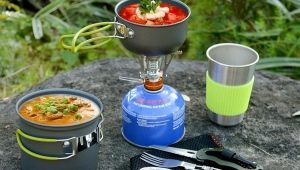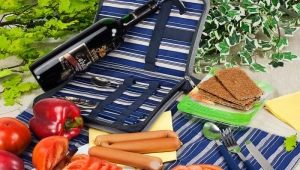All about army bowlers
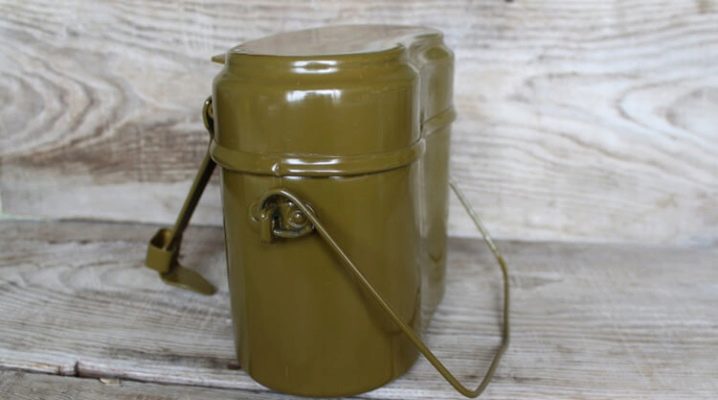
Wars have caused and continue to cause incredible suffering and deprivation to people. But along with this, as a result of them, a variety of things were created that make everyday life easier. One of these things is just a military bowler hat; it's time to take a closer look at it.
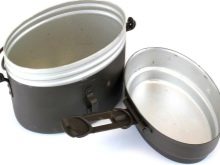
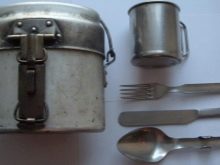
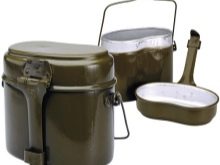
History of creation
That marching army bowler hat, which is familiar to modern military personnel, did not appear immediately. For a long time - back in the 19th century - in our country they attended to the unification of this important subject of the field life of soldiers. Since 1862, personal bowlers with a wire bow and a steel lid have come into use. Nine years later, in 1871, the use of pots with red copper lids began. At the same time, the cavalry units began to receive copper bowls for 3 servings.
But since 1895, in the cavalry, the soldier's bowler hat has been transferred to a single type. In the manufacture of such items, already in that distant era, standards were applied, which were fixed by specially issued orders. However, one should not assume that such an important item of military life appeared only in the second half of the 19th century. The problem of feeding troops on a campaign and in a combat zone became interested much earlier.This is evidenced by the engraving of the 17th century Dutch artist Cornelis Dusarte "Old Age".
On it, an army bowler hat is located almost in the center of the composition and is displayed as detailed as possible. It is clearly seen that despite the much larger dimensions than it is accepted today, the design is quite recognizable.
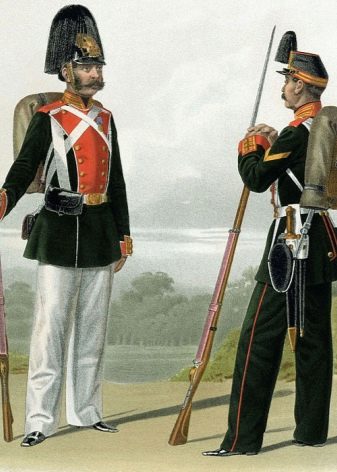

Of course, later these products were repeatedly upgraded and improved significantly. But it is worth mentioning even earlier modifications. The oldest known bowlers were used in the armies of ancient Greek policies.
Then they were made of copper, and the cost of such dishes was very high. Of course, bowlers were also widely used in Rome. There was not a single legion where it was not part of the marching equipment. Already in that era, they came up with the option of installing dishes on a tripod. The so-called barbarian tribes also used cauldrons, but rather in magical rites.
In the Middle Ages, military utensils almost did not differ from those used in antiquity. It was mostly used collectively. In modern times, almost every army is developing its own type of bowler hat. Widespread during World War II unified sample. It has been used in various countries.
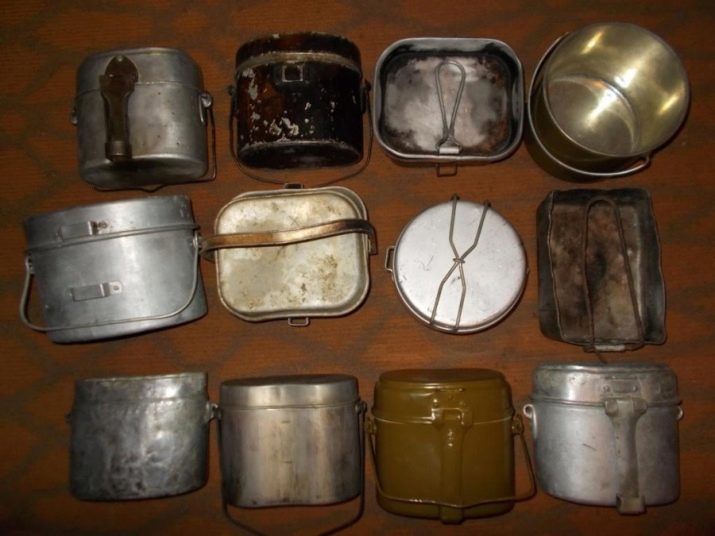
Pros and cons
In any case, all types of bowlers can be used not only for military purposes. They are widely used by tourists, hunters, huntsmen, fishermen and other people who leave for various reasons in an uninhabited area. Camping army kettles are easy to carry and use. With their help, you can cook or reheat:
- first meal;
- second courses;
- herbal decoctions;
- tea;
- simple boiling water.

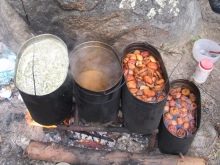

To warm up the dishes, you can use gas and alcohol burners, tagans, even bonfires. Since the products were originally designed for the army, their quality is undeniable. This is expressed:
- in a significant operational resource;
- strength;
- minimal risk of food burning;
- homogeneous distribution of heat;
- optimally selected volume;
- reasonable cost.
But there are also weaknesses. So, a metal pot is easily covered with soot. It is extremely difficult to wash, especially in the field. Metal handles heat up excessively, and therefore there is a high risk of burns. However, a more detailed description can only be given to specific samples.

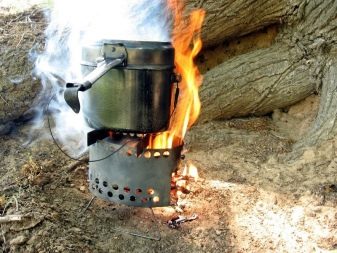
Varieties, their shapes and sizes
Used in Russia, including in the Airborne Forces, a military bowler hat is made either convex-concave or spherical in design. By default, this product is equipped with a wire handle, which facilitates suspension and movement. When the bowler is on the waist belt, the concave side is turned towards you.
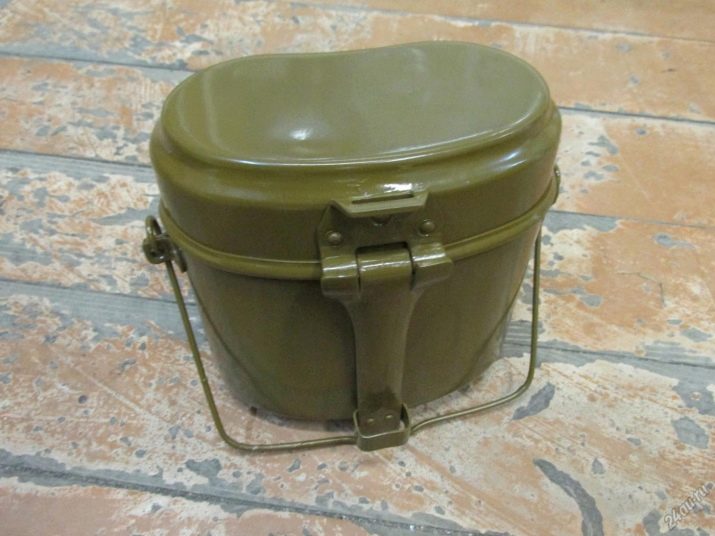
The amphibious cauldron of a combined sample with a flask was officially adopted in September 1959. Production was carried out at the Krasny Vyborzhets factory. With minor inconveniences, the paratrooper's bowler hat, and the kit in general, has not lost its relevance. Until now, it is used in a variety of military branches. The composition of the kit is as follows:
- aluminum flask with a volume of 1 liter;
- a bowler hat (also with a capacity of 1 liter) with a rectangular transport bail;
- 0.5 l podkotelnik bowl with a reclining locking handle;
- canvas cover weighing 0.08 kg.
The landing kit is designed for 1 person. Compared to a typical combined arms boiler, thickened aluminum is used here. Therefore, the designers managed to achieve maximum strength and long service life of their product.The 1 liter capacity is better suited for everyday use than the 1.5 liter for combined arms products. Boiler bowls are more comfortable than bowl lids because they are deeper and, moreover, retain the same volume.
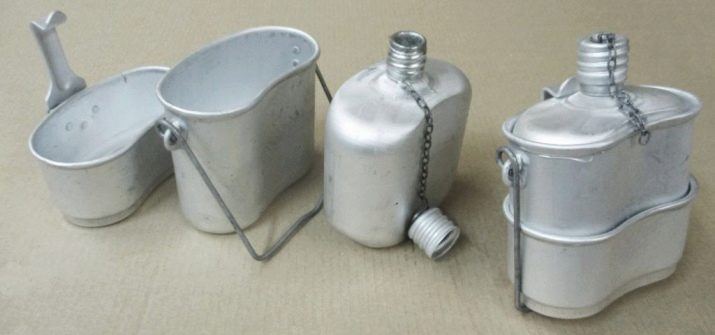
Of course, bowlers adopted in other armies also deserve attention. The French approach for a very long time was to use round bowls. A similar pattern was first used in 1852. For the manufacture of dishes then used tin and sheet iron. The round lid could have been a kind of frying pan; a special chain was used to secure it.
But the French military often removed this chain to reduce walking noise. Almost unchanged, the classic bowler hat was used in the First World War. Only in 1935, rectangular aluminum dishes were put into operation in France. It differed from its German prototype precisely in its shape (in Germany they preferred an oval). The 1935 modification was equipped with an insert bowl.
In 1952, an updated version of the bowler was accepted for supply in France. It has retained its rectangular appearance, and it also contains 3 items. But the construction of the set according to the "matryoshka" pattern and the geometry of the handle indicate the influence of the Anglo-American approach.

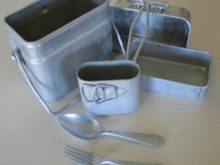

Their modifications of bowlers, however, were in Scandinavia. The Swedish army bowler hat was used not only in the armed forces of Sweden itself, but also in volunteer formations that participated in the Winter War along with the Finnish regular units.
Then two modifications were used - 1895 and 1940. The first type is characterized by large volume and height. It is also worth mentioning that in 1895 the dishes were made of tinned steel, and in the middle of the 20th century they switched to stainless steel.The difference also concerns the shape of the "ears", the method of fixing the handle on the lid and other subtleties. In 1944, the Swedes modernized their development by adding to it:
- wind screen;
- alcohol reservoir;
- alcohol burner.
The 1944 version is made of aluminium. This design was so successful that it is still used by the Swedish military.
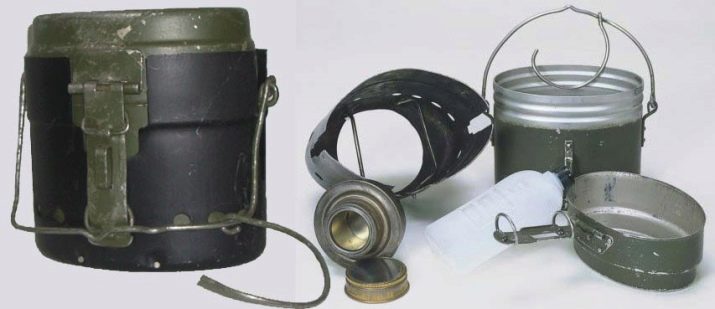
But in the Romanian and Hungarian armies of that time, square bowlers were used, which were accepted for supply in Austria-Hungary in 1912. Some soldiers also used Italian-made camping utensils.
The classic Finnish bowler hat was made in the likeness of a German product. Its size was sufficient so that a special spoon-fork could be placed. So that it can be fixed, the rims of the bowler are covered with special recesses.

As for German-made boilers, the 1931 model of the year is recognized as their classic version. It differs from the sample of the period of the First World War in a smaller volume (not 2.5, but 1.7 liters). Starting in 1943, in order to save aluminum, they switched to the manufacture of steel structures with "lugs".
In addition to the bowlers were used:
- portable heaters;
- folding spoons;
- dinner sets of 3 or 4 items.
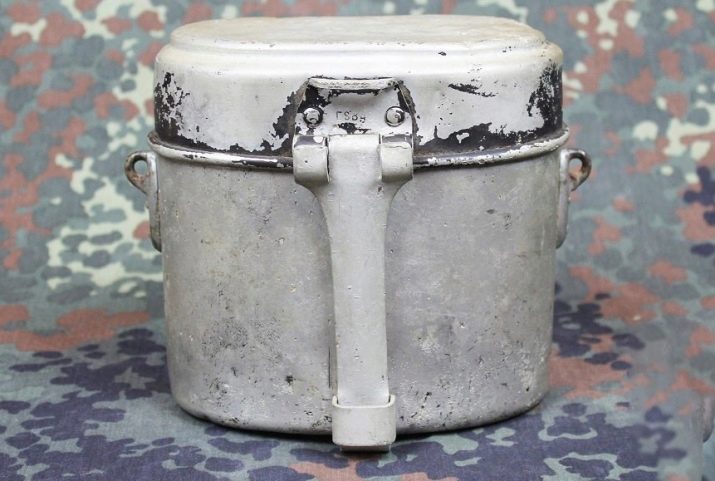
The Polish model of 1931 (Menazka wz. 23/31) "participated" in only one military campaign - an unsuccessful counteraction to fascist aggression in 1939. In subsequent years, the Poles used the ammunition of the army in which they ended up.
Post-war Polish forces initially used surviving stocks of old army utensils. In the 1950s, the production of the 23/31 model was resumed. However, the products of the new generation were no longer made of galvanized steel, but of aluminum.
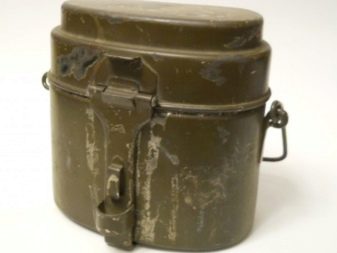
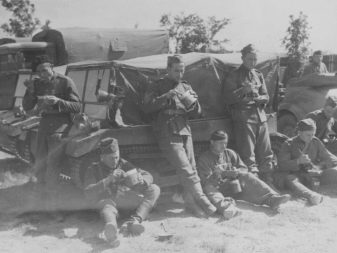
Another model appeared in 1970. From the pre-war version, it differed in the appearance of "ears", which are designed to fasten the handles. The changes also affected the hallmarks and the number of measured marks (they left only 1, while in the old design there were 2). The modification of the bowler hat, adopted by the Bundeswehr, contains:
- the actual food container - 1.5 liters;
- insert bowl - 0.5 l;
- lid with folding handle - 0.5 l.
The product is designed for use both on open fire and on stoves. It is made from aluminium. Dry weight is 0.48 kg. The olive color finish looks very nice.

However, from talking about modifications of camping food utensils, which can be endless, it's time to move on to a review of the properties of individual materials.
materials
Constructions stainless steel are cheaper than other options. Steel modifications are light, however, under the influence of the flame of a fire, they can burn out. This does not happen too often, especially if you use camping utensils only occasionally. People who rarely go to nature successfully use a high-quality steel container for 4–5 years. Cast iron they are used even less often: it is too heavy to be able to go on a long hike with such a product.
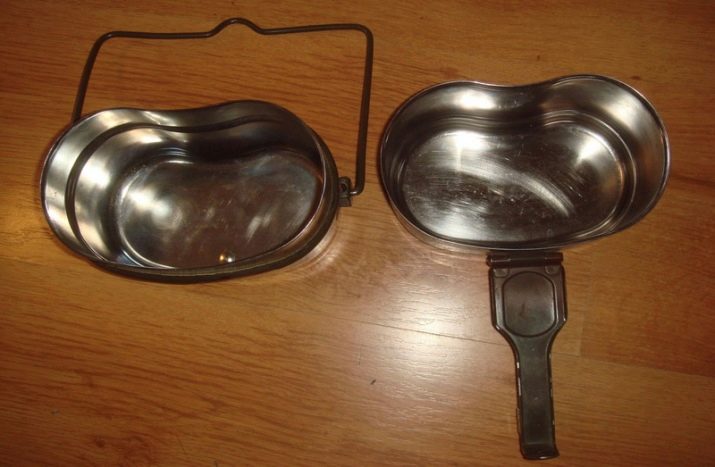
For those traveling by car, however, this circumstance is not very relevant. aluminum pot it is light, does not rust and only occasionally leaks liquid. But you will have to pay a lot of money for such a thing. It is also worth remembering that the reviews mention the danger of burning food. Concerning titanium structures, then they are ideal in terms of practical characteristics, and only a very high cost hinders their distribution.

How to choose?
Spherical camping utensils are needed for those people who most of all appreciate:
- convenience of cooking;
- ease of washing;
- the ability to put other items inside.
But for hiking, this option is hardly suitable, since it is unnecessarily heavy. The oval cauldron can easily be placed in a backpack or placed in a tent. The problem is the uneven heating of the water.
However, if tourists or hunters want to go light and are ready to compensate for the difficulties of cooking with great effort, this is not so important.

The next important point is the geometry of the bowler handle. It should be comfortable for the user's hand. Important: you will have to check whether the handle is strong enough. The optimal volume of the pot is 1 liter per 1 traveler.
The best set is a large three-liter cauldron for cooking + a liter copy for boiling water. The specific manufacturer does not really matter.

Terms of Use
It is worth considering that you can use any camping boiler only after a thorough study of its characteristics. Experienced people have long known that the vast majority of military structures are designed for eating, and not for cooking it. But it is quite possible to fill the pot with fragile or sharp objects before going on a trip, without fear of negative consequences later. Some people even use these utensils to transport half-eaten breakfasts or lunches. You need to wear it:
- in a satchel;
- on a special valve "rusk";
- on the belt;
- on the backpack.
The podkotelnik and the bowler are fixed to each other with the help of a special handle. Guide handles are inserted into special grooves. The resulting block can already be heated on a fire or on another hearth.A wood chip oven can also be used as a hearth. With skillful use, the bowler hat will bring only pleasant emotions.
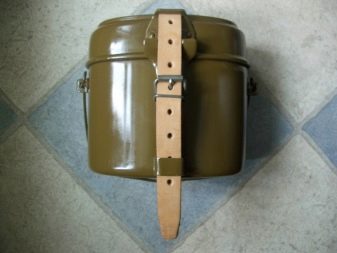

Features of care
Perhaps the most important point in working with a bowler hat is how to wash its surface from grease. The lower part and the lid are washed for this with hot water mixed with dishwashing detergent. Washing should be repeated twice or thrice so that no harmful substances remain.. You can replace the detergent with laundry soap. Then the pot is boiled and rinsed several times in a row.
You can finish the preparation by washing with alcohol. Sometimes bowlers are turned with sandpaper. It is necessary, so that the product does not jam and is not clogged with sand.
Directly in nature, it is very good to wash dishes with sand with the addition of detergent. Instead of detergents, a simple wire is sometimes used.
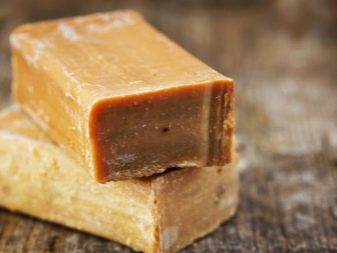

An overview of the army bowler hat, see the following video.






















